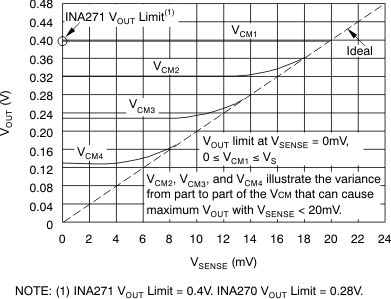ZHCSHF9E February 2007 – January 2018 INA270 , INA271
PRODUCTION DATA.
- 1 特性
- 2 应用
- 3 说明
- 4 修订历史记录
- 5 Device Comparison Table
- 6 Pin Configuration and Functions
- 7 Specifications
- 8 Detailed Description
- 9 Application and Implementation
- 10Power Supply Recommendations
- 11Layout
- 12器件和文档支持
- 13机械、封装和可订购信息
8.4.2.4 Low VSENSE Case 2: VSENSE< 20 mV, 0 V ≤ VCM ≤ VS
This region of operation is the least accurate for the INA270 family. To achieve the wide input common-mode voltage range, these devices use two op amp front ends in parallel. One op amp front end operates in the positive input common-mode voltage range, and the other in the negative input region. For this case, neither of these two internal amplifiers dominates and overall loop gain is very low. Within this region, VOUT approaches voltages close to linear operation levels for Normal Case 2.
This deviation from linear operation becomes greatest the closer VSENSE approaches 0 V. Within this region, when VSENSE approaches 20 mV, device operation is closer to that described by Normal Case 2. Figure 18 shows this behavior for the INA271. The VOUT maximum peak for this case is determined by maintaining a constant VS, setting VSENSE = 0 mV, and sweeping VCM from 0 V to VS. The exact VCM at which VOUT peaks during this case varies from device to device. The maximum peak voltage for the INA270 is 0.28 V; for the INA271, the maximum peak voltage is 0.4 V.
